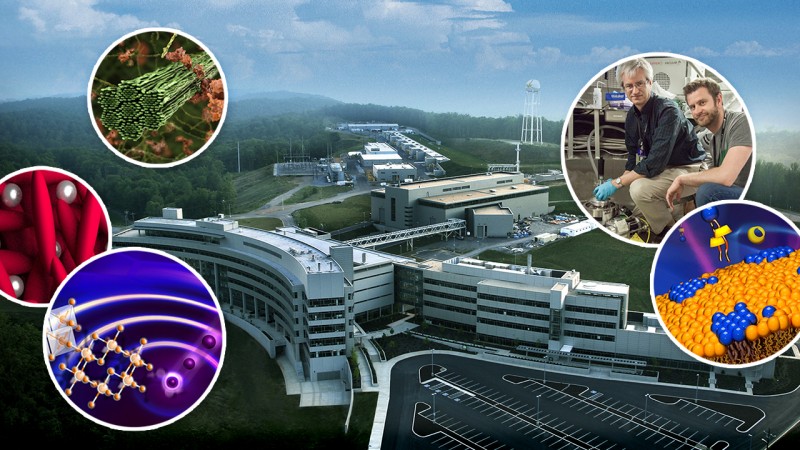In 2006, the first neutrons reached instruments at Oak Ridge National Laboratory’s Spallation Neutron Source, launching a world-leading science program for the investigation of materials. In its 10 years of operation, thousands of researchers from around the world have used the neutrons provided by SNS to address some of the most difficult science questions around.
When a beam of neutrons is aimed at a sample, many neutrons will pass through the material. But some will interact directly with atomic nuclei and "bounce" away at an angle. This behavior is called neutron scattering. Using detectors, scientists can count scattered neutrons, measure their energies and the angles at which they scatter, and map their final position. In this way, scientists can glean details about the nature of materials ranging from liquid crystals to superconducting ceramics, from proteins to plastics, and from metals to micelles to metallic glass magnets.
Some of SNS’s most significant recent highlights are featured here:
- Thermoelectric Devices: Neutron scattering experiments show that lead telluride exhibits a strong anharmonic coupling between its optical and acoustic lattice vibrations. These experiments exploited the high resolution of inelastic neutron scattering over broad dynamic ranges to measure phonon excitation lifetimes. This newly discovered coupling helps explain the low thermal conductivity that makes lead telluride a promising material for thermoelectric devices.
- Quantum Computing: Neutrons helped to uncover novel behavior in materials that may hold long-term promise for quantum computing. Experiments on a two-dimensional material provided evidence for magnetic excitations related to a “Kitaev quantum spin liquid.” The excitations take the form of Majorana fermions—particles that are unusual in that they are their own antiparticles. The presence of magnetic Majorana fermions is of great interest because of their potential use as the basis for a qubit, the essential building block of quantum computers.
- Solar Cells: Researchers used the magnetic moment, penetration, and elemental and isotopic scattering contrast of neutrons to study bulk heterojunction solar cells, finding a way to manufacture the films more easily. The films used by organic bulk heterojunction solar cells to convert solar energy into electricity require annealing, or heating then cooling, to reduce the material’s hardness while increasing its toughness, which makes it easier to work with. Pliability makes BHJs more appealing than their more costly crystalline silicon counterparts, but the annealing process is time consuming. Using neutrons, the team defined the structure of the films and found a simple solvent may make thermal annealing a thing of the past.
- Biofuel Processing: Researchers used neutrons to identify fundamental forces that change plant structures during pretreatment processes used in the production of bioenergy. Pretreatment, the most expensive stage of biofuel production, subjects plant material to extremely high temperature and pressure to break apart the protective gel of lignin and hemicellulose that surrounds sugary cellulose fibers. Neutron contrast variation, the sensitivity of neutrons to hydrogen, and the nondestructive nature of neutrons, helped to provide fundamental insights into the physical forces driving cell wall synthesis and biomass deconstruction.
- Magnetism in Plutonium: Using neutron scattering, researchers made the first direct measurements of a unique characteristic of plutonium’s fluctuating magnetism. Plutonium is not devoid of magnetism, as had been previously thought, but in fact its magnetism is just in a constant state of flux, making it nearly impossible to detect. Using neutron measurements the team determined that the fluctuations are related to changing the number of electrons in plutonium’s outer valence shell—an observation that also explains abnormal changes in plutonium’s volume in its different phases. Neutrons are uniquely suited to this research as they are uniquely able to detect magnetic fluctuations on the time scale relevant for plutonium and many other materials.
- High Entropy Alloys: Researchers used the sensitivity of neutrons to light elements and elements with similar atomic numbers to study high entropy alloys, metals that contain five or more elements mixed evenly in near equal concentrations that have shown exceptional engineering properties, such as high strength at elevated temperatures. Alloys more typically are made up of two or three metals. Using neutron studies, the researchers found that this class of alloy retains enhanced mechanical properties even when the mixing is uneven or disordered, which opens up new possibilities for future alloy design.
- Biological Membranes: ORNL researchers used neutrons to detect lipid domains—nanoscopic cell structures—for the first time, which will help researchers understand how membrane structure controls biological function and could spur innovation of membrane-targeted antibiotics and other treatments.
Read more about the SNS 10th anniversary: https://www.ornl.gov/news/ornl-s-spallation-neutron-source-marks-decade-honors-pioneers-shull-wollan
View photos of the celebration: https://flic.kr/s/aHskHjCzyQ





